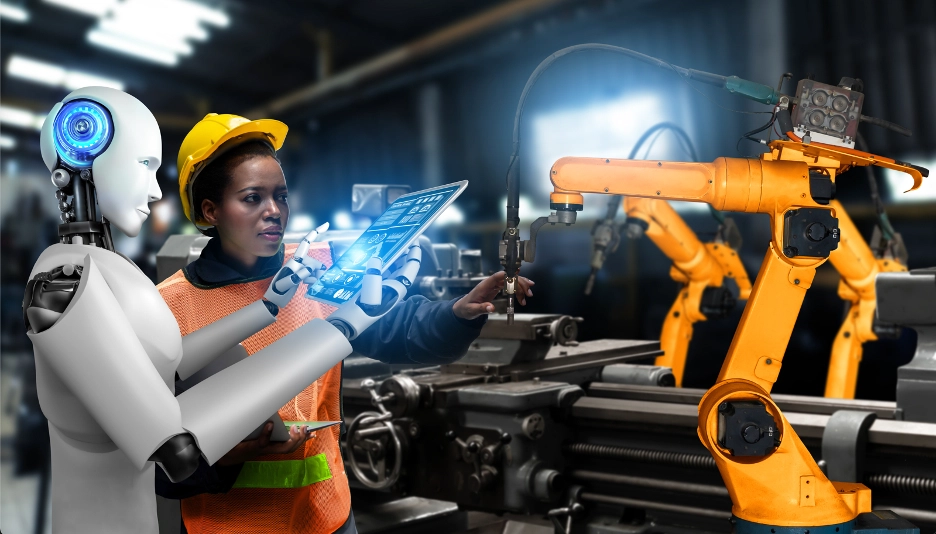
Businesses are on a quest to enhance productivity and address talent shortages through the strategic deployment of advanced technologies. Notably, augmented workforce stands out as an innovative approach with various opportunities. However, to fully unlock its potential, companies need to devise clear strategies.
What is augmented workforce?
Augmented workforce is a growing trend for businesses. Gartner's latest predictions for technology trends in 2024 revealed that 25% of CIOs intend to harness augmented-connected workforce initiatives to reduce 50% of the time required to achieve competency by 2027. Understanding this trend, companies are devising initiatives to adapt to the ever-evolving technology landscape.
Augmented workforce is how humans and technologies (such as AI, robots, and other innovative tools and platforms) can work in harmony in the workplace. Employees can direct efforts toward critical tasks such as complex problem-solving and creative work, while automated systems will take on repetitive and manual tasks. While augmentation and automation share similar characteristics in enhancing efficiency and solving task repetition, augmentation offers a more human-centric approach. Rather than simply replacing workers, augmented workforce enables human-in-the-loop practice where humans work alongside technologies.
Augmented workforce: Bridging the Talent Gap
The majority of augmented workforce is powered by intelligent automation. This means humans can work alongside technologies such as AI and RPA to alleviate labor shortages. Developers can leverage AI tools such as ChatGPT to create applications with less coding effort. As 92% of programmers have embraced AI tools in their workflows, AI allows faster time-to-market for businesses. Thanks to AI democratization, individuals without programming experience can now use this innovative technology to learn and generate code. This has unlocked opportunities for citizen developers, which further frees up effort for software programmers.

AI tools can be a companion for developers.
For instance, healthcare professionals can leverage RPA to reduce administrative tasks and streamline document management. As healthcare professionals usually face difficulties entering data in various formats, claim processing can be streamlined by RPA bots. Besides, automated chatbots can be integrated with the doctors’ schedules to keep track of their patients and reduce manual scheduling. Since NHS loses around £216 million through missed general practice appointments, RPA can automate reminders to reduce missed appointments for healthcare providers and improve patient experience.
Find out how the healthcare industry can leverage digital solutions to solve labor shortage: Resource Shortages in Healthcare: Which Digital Solutions are the Answer?
Augmented workforce, augmented productivity
To catch up with the wave of innovation, FPT Software developed CodeVista as an interactive application utilizing Generative AI system interaction mechanisms. CodeVista is equipped with features to support coding tasks, enhance productivity, and save time for software projects.
Integrated directly within the Integrated Development Environment (IDE), CodeVista eliminates the need for software developers to switch screens. Developers can seamlessly interact with state-of-the-art LLM models to support their coding tasks. Especially, this AI tool can provide feedback for code sections by explaining the code errors, automatically fix coding violations, and auto-complete codes. CodeVista enables FPT Software programmers to communicate with robust Generative AI models such as GPT-4, Gemini Pro, and LLaMA 3.

Currently, CodeVista has been deployed across more than 20 strategic software units at FPT Software. CodeVista contributed to productivity increase, helping developers generate up to 20% total amount of codes. Understanding the potential of this innovation, FPT Software aims to integrate this tool into the FPT ecosystem to enhance programmer productivity and compete with Github Copilot for internal tasks at FPT Software.
Harnessing augmented workforce - Critical steps to take
Embracing the augmented workforce in the age of AI and automation demands a strategic and collaborative approach. To navigate this transformation, businesses should:
- Foster a culture of continuous learning: In today's knowledge-driven business landscape, continuous upskilling of employees becomes imperative. The augmented workforce approach indicates that employee development should be ongoing rather than a one-time event. With rapid advancements in technology and business models, the traditional static workforce model where employees are hired for a specific skill set becomes less effective. Augmented workforce initiative allows employees to adapt and learn new skills, making them more adaptable to changing industry demands.
- Adopting the right technologies: Businesses should adopt technologies aligning with organizational goals. For instance, companies could adopt AI chatbots to answer customer inquiries and reduce manual effort. AI can also be integrated into training programs to enhance employee capabilities. For instance, Stanley Black and Decker – a tool manufacturing company in the U.S. – improved the way workers can learn how to adequately perform job tasks autonomously in plants and distribution centers. By utilizing an AI-powered video learning platform to capture, index, translate, and transfer knowledge to the manufacturing workforce, the company reduced 50% of training time and saved 90% time creating content for the upskilling program.
- Investing in AI: Investing in the latest AI advancements enables companies to create innovative products and services that align with future demands. Forrester predicted that by 2030, an annual expenditure of 79 billion USD will be dedicated to specialized applications aimed at enhancing automation and productivity, particularly in sectors such as security, healthcare, and content marketing. This investment in AI helps companies attract top talent and positions as pioneers in technology. In the long run, such investments can boost economic growth, with a estimated contribution of 15.7 trillion USD to the global economy by 2030.
Harmonizing humans and innovations
Augmented workforce has the potential to transform the way humans work and create new opportunities for businesses. As the technology landscape evolves, organizations need to embrace innovative solutions and navigate current challenges to ensure the harmony between humans and machines.






























